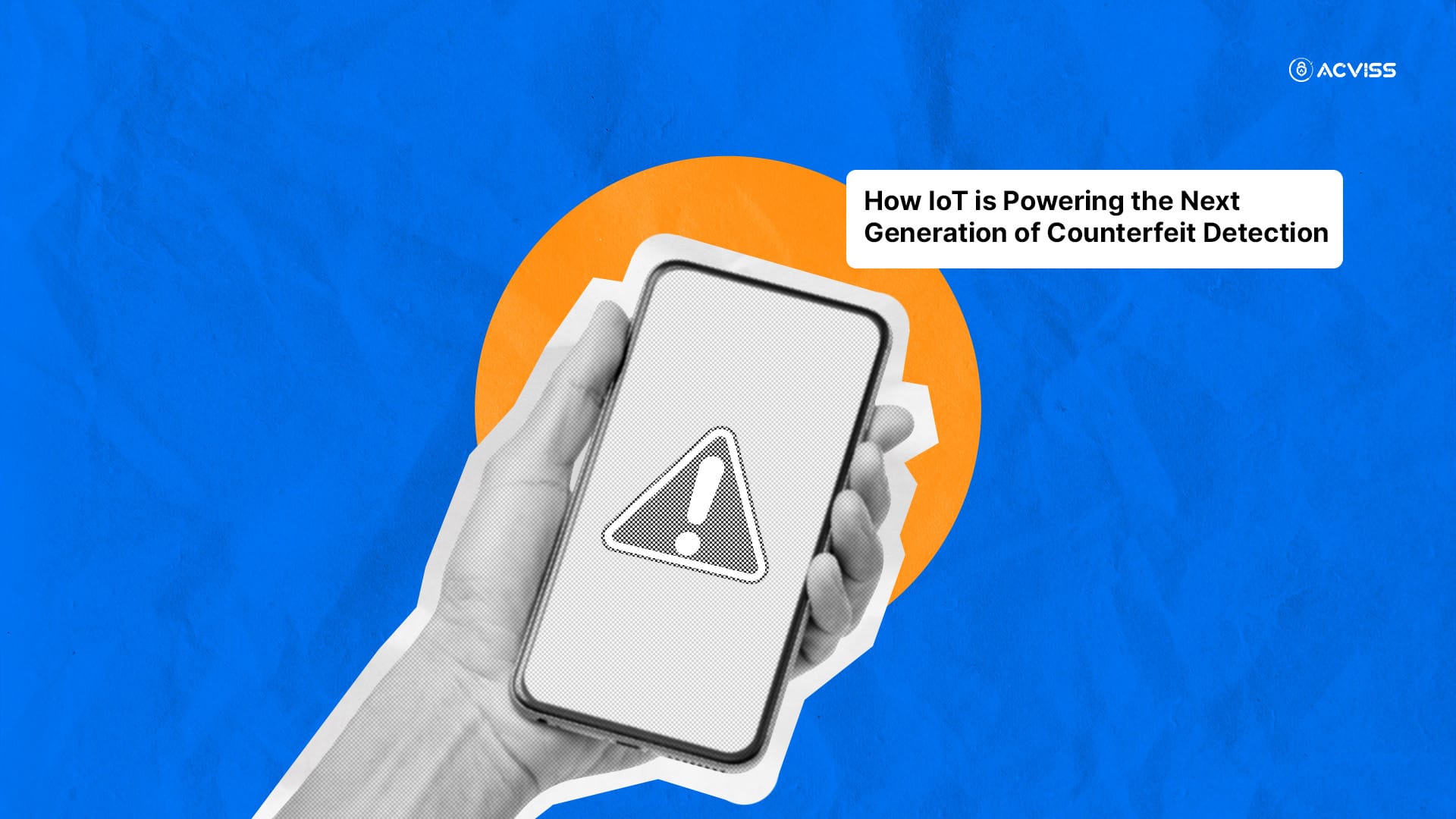How IoT is Powering the Next Generation of Counterfeit Detection in Electronics

Electronics power nearly every facet of modern life, from the microchips in medical devices and cars to the processors driving global communications. Yet, amid this technological marvel lies a growing and dangerous shadow: counterfeit electronic components.
A single fake capacitor, sensor, or microcontroller can lead to catastrophic failures. An aircraft navigation system malfunction, a medical monitor error, or a data centre shutdown- these aren’t hypothetical scenarios but real-world consequences of counterfeit infiltration in the global electronics supply chain.
Visual inspections, random testing, and serial number checks were once sufficient. But counterfeiters have become alarmingly sophisticated, replicating parts that pass surface-level scrutiny and even mimic original performance for short durations. It’s a problem that traditional quality assurance alone can no longer tackle.
Enter the Internet of Things (IoT), a transformative force embedding intelligence, connectivity, and transparency across global manufacturing and supply networks. IoT is no longer just about connecting machines; it’s about empowering brands to detect, trace, and eliminate counterfeits in real time while strengthening brand protection and consumer trust.
The Counterfeit Crisis in the Electronics Industry
Counterfeit electronic components have grown into a multi-billion-dollar crisis. According to the Semiconductor Industry Association, counterfeit chips cost the global electronics industry an estimated $7.5 billion annually. And these are only the reported losses; the hidden costs, from product recalls to reputational damage, are often far greater.
The scale of the problem is vast. Counterfeit components infiltrate consumer electronics, defence systems, telecommunications equipment, and automotive parts. During the global chip shortage triggered by the pandemic, many manufacturers were forced to source components from alternative suppliers, opening doors for counterfeiters to exploit vulnerabilities in the supply chain.
What makes counterfeit electronics particularly insidious is that many pass initial functionality tests. They might operate normally at first, but fail prematurely due to inferior materials, incorrect tolerances, or reused components. The result? Unexpected malfunctions, product failures, and sometimes, safety hazards.
For sectors such as aerospace, healthcare, automotive, and defence, counterfeit infiltration can lead to life-threatening outcomes. A compromised flight control system or a defective pacemaker circuit isn’t just a manufacturing issue; it’s a human risk.
As global supply chains stretch across multiple countries, with components passing through numerous intermediaries, tracking authenticity has become increasingly complex. This is where IoT offers a paradigm shift, creating a connected web of devices and data that turns the supply chain into an intelligent, self-monitoring ecosystem.
How IoT Helps Detect Counterfeit Components

The Internet of Things introduces visibility, accountability, and automation at every stage of the supply chain. Through connected sensors, digital identifiers, and continuous data exchange, IoT builds a dynamic system where authenticity is not assumed but verified in real time.
Let’s explore how it works.
1. Real-Time Tracking Across the Supply Chain
IoT-enabled traceability begins at the point of origin. Every component can be tagged with a unique digital identity, such as an RFID tag, NFC chip, or QR code, that links it to a secure database.
From there, each stage of its journey is recorded: manufacturing, packaging, shipment, storage, and assembly. IoT devices continuously transmit data about location, condition, and custody, creating an unbroken chain of trust.
This level of product traceability is particularly valuable in identifying where and how counterfeit parts might enter the system. If a product suddenly appears in a location not listed in its authorised route or lacks a verified scan record, the system immediately flags it for inspection.
Solutions like Origin exemplify this approach by enabling track and trace capabilities throughout the supply chain. Manufacturers gain end-to-end visibility, ensuring that each component’s journey, from factory floor to final product, is recorded and verified.
This digital chain of custody makes unauthorised substitutions almost impossible. Every transaction, transfer, or handling point is digitally logged, providing auditable proof of authenticity that strengthens both brand verification and IP protection.
2. Environmental and Condition Monitoring
Counterfeiting isn’t always about substitution. Sometimes, genuine components become compromised through improper handling, exposure to high humidity, temperature fluctuations, or electrostatic discharge can degrade parts.
IoT smart sensors, embedded in packaging or shipping containers, can monitor environmental parameters such as temperature, humidity, vibration, and light exposure in real time.
If a batch of semiconductors, for example, is stored in conditions that deviate from prescribed standards, the system can automatically alert quality control teams. This not only helps in detecting tampering or mishandling but also safeguards product safety and reliability.
In industries where compliance is non-negotiable, such as aerospace or medical electronics, this real-time environmental tracking ensures every component meets the stringent product authentication standards set by regulators.
Through predictive data analytics, manufacturers can also identify patterns that suggest counterfeit risks, enabling preventive action before parts reach the assembly line.
3. Integration with Blockchain for Immutable Records
While IoT provides continuous data capture, blockchain technology ensures that the captured data remains tamper-proof. The synergy between IoT and blockchain forms the backbone of the next generation of anti-counterfeiting solutions.
Each data point generated by IoT sensors, be it a shipment timestamp, QR code scan, or temperature reading, is recorded on a distributed ledger. Once written, these entries cannot be modified or deleted, creating an immutable record of every component’s lifecycle.
This combination ensures data integrity and transparency across the supply chain. Manufacturers, distributors, and regulators can verify a component’s authenticity through a single, shared source of truth.
In essence, IoT collects the “what, where, and when,” while blockchain ensures that “what’s recorded stays true.” Together, they build the foundation of brand authentication and IP protection, making it extremely difficult for counterfeiters to manipulate or falsify data.
4. Predictive Analytics and AI-Driven Detection
One of the most transformative applications of IoT in counterfeit detection lies in its integration with artificial intelligence (AI) and machine learning (ML).
As billions of data points flow through IoT networks, AI models can analyse them in real time to identify anomalies or suspicious patterns. For instance, if a batch of components deviates from normal shipping routes or sensors detect unusual vibration levels, the system can trigger alerts instantly.
This predictive capability transforms counterfeit detection from reactive to proactive. Instead of waiting for a fault or customer complaint, manufacturers can intervene early, isolating potential risks before they escalate into major issues.
The more data these AI systems process, the smarter they become, constantly improving accuracy in identifying counterfeit signatures. Over time, IoT ecosystems evolve into self-learning systems, capable of detecting even subtle deviations that human inspectors might miss.
Challenges of IoT Integration in Counterfeit Detection

Despite its vast potential, implementing IoT-based anti-counterfeiting technologies is not without challenges. For many manufacturers, the path to a fully connected and secure supply chain involves navigating multiple barriers.
1. Cost and Infrastructure
Deploying IoT across global networks requires investment in hardware sensors, data management systems, and connectivity infrastructure. For large-scale manufacturers, this can mean retrofitting existing systems or upgrading logistics platforms to accommodate real-time monitoring.
However, the long-term return on investment is undeniable. The cost of counterfeit-induced recalls, reputational harm, and legal penalties often far outweighs the initial expenditure on IoT deployment.
2. Data Overload
IoT systems generate vast volumes of data. Filtering meaningful insights from this deluge requires robust analytics frameworks. Without efficient data processing and visualisation, manufacturers risk being overwhelmed by information without actionable outcomes.
The key lies in integrating IoT with intelligent analytics, transforming raw data into predictive insights that guide decision-making.
3. Cybersecurity Risks
While IoT enhances visibility, it also introduces potential cyber vulnerabilities. Unsecured IoT endpoints can be exploited by hackers seeking to alter data or disrupt operations.
Manufacturers must adopt secure encryption, device authentication, and network segmentation to protect sensitive supply chain data. A compromised IoT network can create new risks if not adequately protected.
Yet, even with these challenges, the advantages of IoT-enabled brand protection solutions are overwhelming. By creating a connected ecosystem of transparency, verification, and security, manufacturers can dramatically reduce counterfeit risks and enhance customer satisfaction through trustworthy, safe products.
Benefits of IoT in Counterfeit Detection
The rewards of IoT integration extend far beyond counterfeit prevention. It transforms supply chain management into a real-time, intelligent, and customer-centric operation.
1. Real-Time Visibility
IoT offers continuous visibility into every product’s lifecycle. Manufacturers can trace a component’s path in real time, identify bottlenecks, and quickly detect unauthorised activities. This track and trace visibility enables swift isolation of counterfeit batches, preventing widespread contamination.
2. Early Risk Detection
By constantly monitoring environmental and logistical data, IoT systems generate immediate alerts for irregularities. Early detection not only prevents counterfeit infiltration but also reduces downtime and warranty claims, safeguarding customer engagement and brand trust.
3. Strengthened Supply Chain Integrity
Integrating IoT with digital traceability tools like Certify and Origin ensures every product’s authenticity is validated at every step.
- Certify enables product verification and authentication, allowing brands to embed secure, non-cloneable codes that customers and partners can verify in seconds.
- Origin provides an immutable record of a product’s journey, empowering supply chain management teams with full transparency and control.
Together, these technologies establish a tamper-proof, data-backed ecosystem, where each product becomes its own proof of authenticity.
4. Enhanced Customer and Partner Confidence
When brands can demonstrate that each component is genuine, tested, and traceable, it strengthens trust across the entire network, from suppliers and distributors to end consumers.
Customers no longer rely on packaging or reputation alone; they can verify authenticity instantly, enhancing brand loyalty and satisfaction. For business partners, it translates to reduced risk, stronger collaborations, and improved compliance with global trade regulations.
The Future: Smart, Connected, and Self-Verifying Supply Chains

The next generation of counterfeit prevention lies in self-verifying supply chains, ecosystems where products authenticate themselves through embedded identifiers, encrypted communication, and machine intelligence.
IoT will play a pivotal role in building this future. As devices become smaller, cheaper, and more powerful, each component can carry its own digital identity and security credentials. These identifiers, combined with AI-powered analytics and smart contracts, can automatically verify authenticity without manual intervention.
Imagine a world where every electronic part, from a resistor to a circuit board, broadcasts its authenticity to connected systems, eliminating doubts, paperwork, and costly inspections.
Furthermore, physical authentication technologies such as non-cloneable labels, like Acviss’s Uniqolabel, can work in harmony with IoT ecosystems. These labels provide a unique, physical-digital bridge that even the most advanced counterfeiters cannot replicate.
When IoT data confirms movement, blockchain secures transactions, and physical labels validate origin, counterfeiters are left with no entry point. This convergence marks a new era of brand authentication, IP protection, and supply chain resilience.
Conclusion
The fight against counterfeiting in the electronics industry is not just about protecting profits; it’s about protecting people, products, and trust.
As counterfeiters evolve their tactics, IoT-powered traceability and authentication give manufacturers a competitive edge. By embedding intelligence into every component, securing data with blockchain, and validating authenticity through solutions like Certify and Origin, brands can create supply chains that are transparent, resilient, and self-verifying.
IoT is no longer just a connectivity tool; it’s the foundation for secure, data-driven brand protection, ensuring that every product reaching the customer is genuine, safe, and trustworthy.
Interested to learn more about how IoT and digital traceability can safeguard your brand? Get in touch with us today.
FAQs
1. How does IoT prevent counterfeit parts from entering the supply chain?
IoT enables continuous tracking of every product movement, condition, and transaction. Any deviation or unauthorised entry triggers instant alerts, helping manufacturers identify and isolate counterfeit risks early.
2. What role does blockchain play in IoT-based counterfeit detection?
Blockchain complements IoT by ensuring data integrity. Each event recorded by IoT devices is stored on a tamper-proof ledger, creating a secure, auditable trail for every product’s journey.
3. Can small manufacturers afford IoT-based counterfeit detection systems?
Yes. With scalable IoT solutions and cloud-based platforms, even mid-sized manufacturers can deploy track and trace systems without heavy infrastructure investments.
4. How do non-cloneable labels enhance IoT-based security?
Non-cloneable labels link the physical product to its digital identity. They create a tamper-proof connection that IoT systems can verify in real time, ensuring that no duplicate or forged label can deceive the system.
